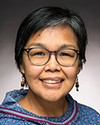Thank you, Mr. Chair. Please cut me off if I drag on.
Kwe kwe. Ullukkut. Tansi. Hello.
Before I begin, I would like to acknowledge that Canada's Parliament is located on the unceded traditional territory of the Algonquin Anishinaabeg people.
I'd like to thank the chair of the committee for inviting me to appear today to speak about Bill C-29, an act to provide for the establishment of a national council for reconciliation.
I look forward to answering these questions, because strengthening this bill and ensuring we move forward on this are priorities for all of us.
We marked the second National Day for Truth and Reconciliation on September 30, last Friday. Indigenous and non-indigenous people across the country came together in their orange shirts to continue to learn about the legacy of the residential schools and the intergenerational impacts. Orange shirts alone are not enough, though. We have to continue to take concrete steps towards reconciliation.
As committee members know, the Truth and Reconciliation Commission published its final report and calls to action seven years ago. Among the commission's calls to action, number 53 calls upon Parliament to establish a national council for reconciliation, while numbers 54, 55 and 56 expanded on the roles, responsibilities, and expectations for the council and the various levels of government. These calls to action are saying that, as a country, we need to measure our progress on reconciliation. We must be held accountable for our promises to indigenous peoples.
That's why we must implement the calls to action as envisioned by the TRC. It's important that the board of the national council for reconciliation be diverse and reflective of all indigenous people in Canada. If the bill is passed, as Minister of Crown-Indigenous Relations, I would collaborate with a transitional committee to appoint the first board of directors. The first council would then establish a process to nominate and elect future board directors, in accordance with the legislation stipulated in the bill.
The board would comprise nine to 13 directors, at least two-thirds of whom are indigenous. Three directors must be nominated by the Assembly of First Nations, Inuit Tapiriit Kanatami and the Métis National Council, respectively. These criteria would apply to the first board, as well as to the future board once the council is incorporated.
In particular, the council will include representation from first nations, Inuit, Métis, indigenous organizations, youth, women, men, gender diverse persons, and various regions in Canada, including urban, rural and remote regions.
It is important to understand that the government does not own or dictate this process. This is a collaboration, and it has been since the beginning, as this bill was jointly developed with indigenous leaders.
Indigenous leaders led the interim board and transitional committee. They provided independent advice and recommendations that were instrumental in shaping the legislative framework before you.
One example of those recommendations is the decision to set up the council as a not-for-profit entity. Incorporating the national council for reconciliation as a not-for-profit organization under the Canada Not-for-profit Corporations Act utilizes the existing legislation to set up the council. Moreover, it establishes and enables the council to be incorporated as a legal entity that operates completely independently from the Government of Canada. It will give the council legal status under the act and allow it to, for example, freely enter into contracts and have bank accounts. The council will also be able to independently fundraise for projects and future work.
It's important to note that budget 2019 announced a total of $126.5 million in funding for the national council for reconciliation, including $1.5 million to support the first year of operation. The funding can be used by the board to establish their endowment for future work, which was very important to the interim board.
I am grateful to the TRC commissioners, the interim board members, the transitional committee members, survivors, and especially the families, and all indigenous and non-indigenous people who participated in the engagement process. Their contribution was essential in shaping this important legislation.
I am happy to answer all your questions.
Meegwetch. Qujannamiik. Marsee. Thank you. Merci.





